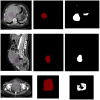Performance Analysis of Segmentation and Classification of CT-Scanned Ovarian Tumours Using U-Net and Deep Convolutional Neural Networks
- PMID: 37443676
- PMCID: PMC10341135
- DOI: 10.3390/diagnostics13132282
Performance Analysis of Segmentation and Classification of CT-Scanned Ovarian Tumours Using U-Net and Deep Convolutional Neural Networks
Abstract
Difficulty in detecting tumours in early stages is the major cause of mortalities in patients, despite the advancements in treatment and research regarding ovarian cancer. Deep learning algorithms were applied to serve the purpose as a diagnostic tool and applied to CT scan images of the ovarian region. The images went through a series of pre-processing techniques and, further, the tumour was segmented using the UNet model. The instances were then classified into two categories-benign and malignant tumours. Classification was performed using deep learning models like CNN, ResNet, DenseNet, Inception-ResNet, VGG16 and Xception, along with machine learning models such as Random Forest, Gradient Boosting, AdaBoosting and XGBoosting. DenseNet 121 emerges as the best model on this dataset after applying optimization on the machine learning models by obtaining an accuracy of 95.7%. The current work demonstrates the comparison of multiple CNN architectures with common machine learning algorithms, with and without optimization techniques applied.
Keywords: DenseNet; Dice score; Jaccard score; ResNet; UNet; VGG 16; convolutional neural networks; ovarian tumours.
Conflict of interest statement
The authors declare no conflict of interest.
Figures










Similar articles
-
An Empirical Evaluation of a Novel Ensemble Deep Neural Network Model and Explainable AI for Accurate Segmentation and Classification of Ovarian Tumors Using CT Images.Diagnostics (Basel). 2024 Mar 4;14(5):543. doi: 10.3390/diagnostics14050543. Diagnostics (Basel). 2024. PMID: 38473015 Free PMC article.
-
Multiple skin lesions diagnostics via integrated deep convolutional networks for segmentation and classification.Comput Methods Programs Biomed. 2020 Jul;190:105351. doi: 10.1016/j.cmpb.2020.105351. Epub 2020 Jan 23. Comput Methods Programs Biomed. 2020. PMID: 32028084
-
Automated detection of leukemia by pretrained deep neural networks and transfer learning: A comparison.Med Eng Phys. 2021 Dec;98:8-19. doi: 10.1016/j.medengphy.2021.10.006. Epub 2021 Oct 13. Med Eng Phys. 2021. PMID: 34848042
-
Deep learning for colon cancer histopathological images analysis.Comput Biol Med. 2021 Sep;136:104730. doi: 10.1016/j.compbiomed.2021.104730. Epub 2021 Aug 4. Comput Biol Med. 2021. PMID: 34375901 Review.
-
Machine learning algorithms in microbial classification: a comparative analysis.Front Artif Intell. 2023 Oct 19;6:1200994. doi: 10.3389/frai.2023.1200994. eCollection 2023. Front Artif Intell. 2023. PMID: 37928448 Free PMC article. Review.
Cited by
-
An enhanced deep learning model for accurate classification of ovarian cancer from histopathological images.Sci Rep. 2025 Jul 1;15(1):21860. doi: 10.1038/s41598-025-07903-9. Sci Rep. 2025. PMID: 40594738 Free PMC article.
References
LinkOut - more resources
Full Text Sources

